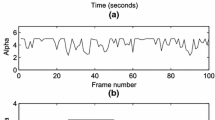Abstract
An open-source simulator to design and implement circuits and systems, replicating the results from the Field Programmable Analog Array (FPAA) is presented here. The fundamental components like the transistors, amplifiers and floating gate devices have been modeled based on the EKV model with minimal parameters. Systems including continuous-time filters and the analog front-end of a speech processing system have been built from these basic components and the simulation results and the data from the FPAA are shown. The simulated results are in close agreement to the experimental measurements obtained from the same circuits compiled on the FPAA fabricated in a 350 nm process.











Similar content being viewed by others
Notes
[19], Chap. 5, pp. 68.
References
George, S., Kim, S., Shah, S., Hasler, J., Collins, M., Adil, F., et al. (2016). A programmable and configurable mixed-mode FPAA soc. IEEE Transactions on Very Large Scale Integration (VLSI) Systems, 24(6), 2253–2261.
Michell, G. D., & Gupta, R. K. (1997). Hardware/software co-design. Proceedings of the IEEE, 85(3), 349–365.
Collins, M., Hasler, J., & George, S. (2016). An open-source tool set enabling analog-digital-software co-design. Journal of Low Power Electronics and Applications, 6(1), 3.
Schlottmann, C. R., & Hasler, J. (2014). High-level modeling of analog computational elements for signal processing applications. IEEE Transactions on Very Large Scale Integration (VLSI) Systems, 22(9), 1945–1953.
Foty, D. P. (1997). MOSFET modeling with SPICE: Principles and practice. Upper Saddle River, NJ: Prentice-Hall.
Cheng, Y., & Hu, C. (2002). MOSFET modeling & BSIM3 user guide. Berlin: Springer.
Tsividis, Y. P., & Suyama, K. (1994). MOSFET modeling for analog circuit cad: problems and prospects. IEEE Journal of Solid-State Circuits, 29(3), 210–216.
Guerra-Gómez, I., Mcconaghy, T., & Tlelo-Cuautle, E. (2013). Operating-point driven formulation for analog computer-aided design. Analog Integrated Circuits and Signal Processing, 74(2), 345–353.
Hasler, J., Shah, S., Kim, S., Lal, I. K., & Collins, M. (2016). Remote system setup using large-scale field programmable analog arrays (FPAA) to enabling wide accessibility of configurable devices. Journal of Low Power Electronics and Applications, 6(3), 14.
Schlottmann, C., Petre, C., & Hasler, P. E. (2012). A high-level simulink-based tool for FPAA configuration. IEEE Transactions on Very Large Scale Integration (VLSI) Systems, 20(1), 10–18.
Campbell, S. L., Chancelier, J.-P., & Nikoukhah, R. (2006). Modeling and simulation in Scilab/Scicos. New York, NY: Springer.
Lam, K.C.A., & Zwolinski, M. (June 2013). Circuit simulation using state space equations. In 2013 9th Conference on Ph.D. Research in Microelectronics and Electronics (PRIME) (pp. 177–180).
Tiller, M. (2001). Introduction to physical modeling with modelica. Berlin: Springer.
Enz, C. C., Krummenacher, F., & Vittoz, E. A. (1995). An analytical MOS transistor model valid in all regions of operation and dedicated to low-voltage and low-current applications. Analog Integrated Circuits and Signal Processing, 8(1), 83–114.
Low, A., & Hasler, P. (1999). Cadence-based simulation of floating-gate circuits using the EKV model. In 42nd Midwest Symposium on Circuits and Systems (vol. 1, pp. 141–144).
Hasler, P. E. (2005). Floating-gate devices, circuits, and systems, invited. In Proceedings of the 5th IEEE International Workshop on System-on-Chip for Real-Time Applications (IWSOC 2005), 20-24 July 2004, Banff, Alberta, Canada (pp. 482–487).
Tsividis, Y. P. (1987). Operation and modelling of the MOS transistor. New York, NY: McGraw-Hill.
Odame, K. M., & Hasler, P. E. (2009). Theory and design of OTA-C oscillators with native amplitude limiting. IEEE Transactions on Circuits and Systems, 56–I(1), 40–50.
Mead, C. (1989). Analog VLSI and neural systems. Bostan, MA: Addison-Wesley Longman Publishing Co., Inc.
Kim, S., Hasler, J., & George, S. (2016). Integrated floating-gate programming environment for system-level ics. IEEE Transactions on Very Large Scale Integration (VLSI) Systems, 99, 1–9.
Schlottmann, C., Abramson, D. N., & Hasler, P. E. (2012). A MITE-based translinear FPAA. IEEE Transactions on Very Large Scale Integration (VLSI) Systems, 20(1), 1–9.
Graham, D. W., Farquhar, E., Degnan, B., Gordon, C., & Hasler, P. (2007). Indirect programming of floating-gate transistors. IEEE Transactions on Circuits and Systems I: Regular Papers, 54(5), 951–963.
Chawla, R., Adil, F., Serrano, G. J., & Hasler, P. E. (2007). Programmable g\({}_{\text{m}}\)- C filters using floating-gate operational transconductance amplifiers. IEEE Transactions on Circuits and Systems, 54–I(3), 481–491.
Graham, D. W., Hasler, P. E., Chawla, R., & Smith, P. D. (2007). A low-power programmable bandpass filter section for higher order filter applications. IEEE Transactions on Circuits and Systems I: Regular Papers, 54(6), 1165–1176.
Ramakrishnan, S., Basu, A., Chiu, L. K., Hasler, J., Anderson, D., & Brink, S. (2014). Speech processing on a reconfigurable analog platform. IEEE Transactions on Very Large Scale Integration (VLSI) Systems, 22(2), 430–433.
Ngspice Web Site. http://ngspice.sourceforge.net/.
Nenzi, P., & Vogt, H. Ngspice users manual. http://ngspice.sourceforge.net/docs/ngspice26-manual.pdf.
EKV Website, http://ekv.epfl.ch/.
Degnan, B. (2013). Temperature robust programmable subthreshold circuits through a balanced force approach. Ph.D. dissertation, Georgia Institute of Technology, Atlanta, GA, May 2013.
Author information
Authors and Affiliations
Corresponding author
Rights and permissions
About this article
Cite this article
Natarajan, A., Hasler, J. Modeling, simulation and implementation of circuit elements in an open-source tool set on the FPAA. Analog Integr Circ Sig Process 91, 119–130 (2017). https://doi.org/10.1007/s10470-016-0914-y
Received:
Revised:
Accepted:
Published:
Issue Date:
DOI: https://doi.org/10.1007/s10470-016-0914-y




